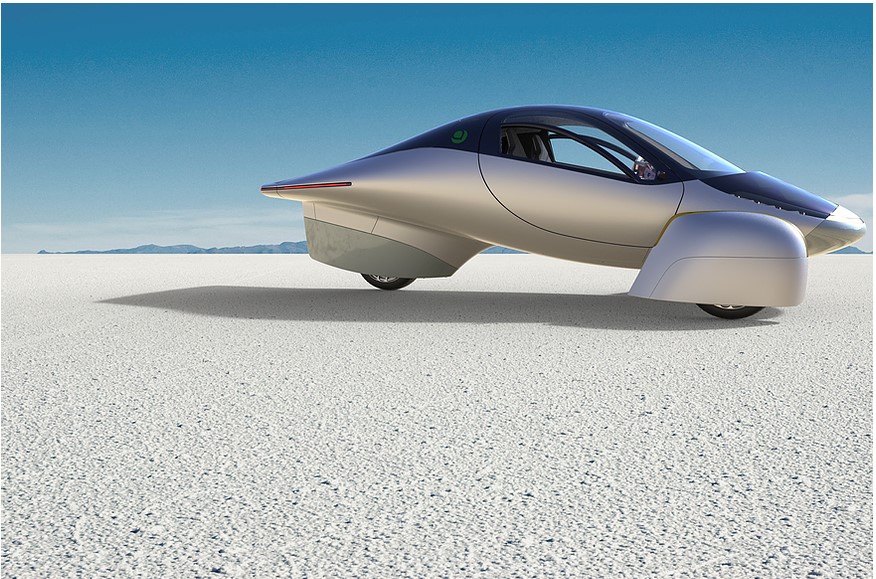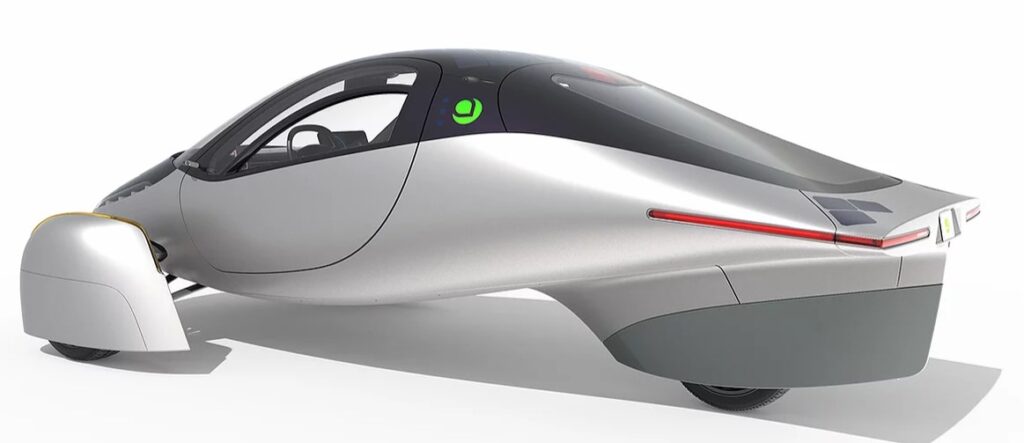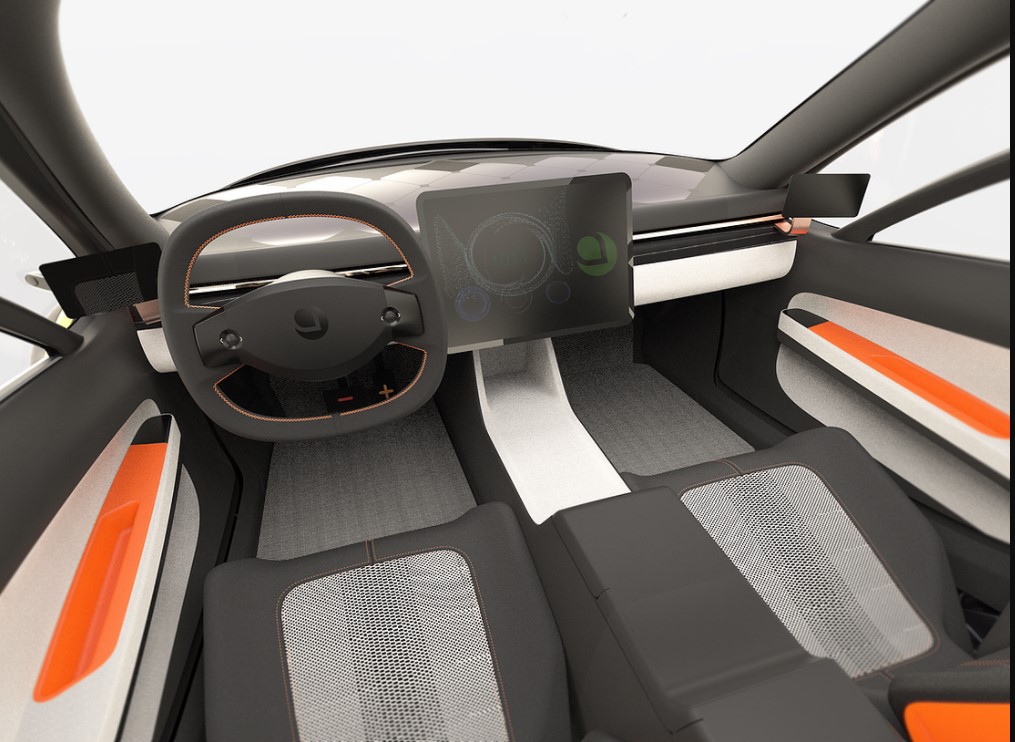Ready to Fly at Last?
In the growing world of EVs, the Aptera stands out for its unusual design, incredible range and the company’s plucky chutzpah. I attended a fascinating Zoom presentation by Jason Hill, the company’s designer, where he kindly provided details and shared his excitement.
Company History, in Brief
The company was founded in 2005 by Steve Fambro and Chris Anthony, but faltered and closed down in 2011. But–hope springs eternal–after a circuitous path, Aptera rose again in 2019 under the original founders. They and their team worked quietly behind the scenes, including a painstaking redesign of the car as a full electric vehicle. In December 2020 they introduced the Aptera 3 and announced a crowdsourcing campaign, which quickly generated 3,000 deposits from eager customers.

Jason Hill, Designer
Jason Hill remembers seeing the extremely aerodynamic original Aptera on the cover of Popular Science magazine. When the company restarted, the founders went looking for a designer and, through a friend, Jason was offered the job.
Jason is founder and president of Eleven LLC, a design studio whose clients include Subaru and other automotive entities. He was the first designer at Porsche’s American design studio, working on the exterior of the Porsche Carrera GT show car.
“I support the vision of the efficiency model and what that means for mobility, transportation and vehicle design,” said Jason [all following quotes in this story are from him].
Jason found that they had never really stopped working on the car, but he believes that now is the right time to produce it.
“The technology, processes and general environment have caught up to where Aptera can be a leader in this space.”
The Shape
Jason’s task as designer was to mix the engineering with the aesthetics and uphold the company’s design ethos.
Aptera means “wingless” in Greek, and is a great name for the car, because it really looks like a wingless airplane. The company likes to translate Aptera as “wingless flight,” but it’s not taking inspiration from the actual wingless flying insects to whom the term is applied.
Design is at the heart of Aptera, as Jason explained in detail during his online session for investors, journalists and other interested parties.
The car has room for two people; the designer’s goal was to maximize vision, comfort and the “reach envelope” for the activities inside the car.
“We wanted the perfect shape for aerodynamic functionality, low weight and a high level of design.”
Packaging
The design goal was to tackle the question of housing both people and the powertrain, including the batteries. Jason says that for the Aptera 3 redesign, they started on the inside and worked their way out, rather than designing a perfect body and trying to fit the pieces inside it.
“We started with the base of batteries and balanced that with the needs of the shape for the best balance.” They put the batteries into smaller, higher-density packs, so they could fit them more precisely into the vehicle.

The overall design process, per Jason, is to seek the best advice, and not defer to a single decision or direction.
“If it fits, it goes that way. Nothing is superfluous, and nothing is left out.”
That comes down to a “rightness” from having the best user functionality, where the reach to the controls, cupholder locations, materials, colors and finish have a premium feel, but are cost-effective to produce. As seen in other EVs, recycled materials appear here, and per Jason, there’s a much greater variety of sources now from which to procure them.
The Right User Experience
No matter what the shape of a car looks like, most of the human interaction with it is inside, so it has to be right. Jason has given this much thought.
“Functionality—needs and wants—has to balance out.”
For instance, the original interior design had a single screen with all the information on it and three rear vision cameras. Jason says they can do better now. He listens widely to the words he hears from leadership and tries to match them to the vision.
“That’s exactly what I was talking about” is what Jason wants to hear when he unveils a new design.
The Aptera is designed to accommodate most people, so it’s designed around the 95th percentile human—typically a 6-foot-2 adult male—but able to accommodate short people, too.
The design ethos is about engaging the driver and passenger.
“We wanted it to be free of hassle and clumsiness. So, there’s no key fob and not a bunch of buttons and distractions. We wanted it to feel clean and luxurious, but not to be missing anything.”
Unique Interior Features
The Aptera features a center console cover that incorporates a phone charger. There’s also a soft glovebox that sits on the dashboard, not in it. Drivers can store items safely in a backpack that lives on the back of the seat. The rear storage area will be convertible into a camper with a new tent feature that’s being designed with a “tent developer.”

“We wanted to give freedom of mobility and heartfelt limited use of resources—to go far using little.” This includes traveling to out-of-the-way places.
The steering wheel started out quite square but has evolved into a more rounded shape. Jason paid special attention to how it feels in your hands, aiming for the right thickness and providing adjustability.
The rear-view mirrors use a video camera system with high-fidelity feedback—better than a regular mirror. You can also select a standard mirror with a click. The regular rearview mirror is tied in with side cameras for a wider field of vision.
A Different Exterior
Cars are starting to use phone apps as a key—a la Tesla—and the Aptera adds something special—three round lights on the side near the upper part of the butterfly-style doors. They provide a visual cue for locking and unlocking the vehicle. The owner waves his/her hand over the door pillar and the lights display sequentially upwards for unlocking and downwards for locking. The Aptera logo next to them remains lit all the time.
The Aptera looks a little like a stripped-down hotrod, with its exposed wheel linkages. The wheels are covered with wheel pans, which move with the wheels when turning. Design and engineering are working together to make sure changing a tire will be easy.
Solar Technology
The surface and dashboard top of this latest Aptera are covered with solar panels, laid out in an elegant diamond pattern. Jason found that turning the square panels at an angle allowed more of them to be placed on the car. These panels can generate up to 41 miles of range per day. Since most drivers drive less than that, you could technically never plug the Aptera in. This would be the first EV to be able to claim that distinction.
Why Three Wheels?
Three wheels instead of four eliminates some weight while maintaining stability. Of course, having the batteries at the bottom of all electric cars provides a lower center of gravity, reducing the risk of turning over and enhancing handling. Jason said they will consider different sizes and widths that are most efficient and also can adapt them for different markets. [Ed. note: Three wheels also means it doesn’t have to meet the stringent safety regulations of a four-wheel vehicle.]
Jason Sums It Up
“The process is so rewarding—to be part of setting goals and seeing their manifestation. The style part is one thing, but mixing it with efficiency is even better. This gives us freedom of mobility.”
Order Yours
Tempted to have one of your own? Aptera’s website claims up to a 1,000-mile battery range at the top level with a $44,900 price. The entry-level model, with a 250-mile-range, starts at under $26,000. You can get on the orderlist with a $100 deposit.
Story by Steve Schaefer. Photos from the manufacturer
Related Stories You Might Enjoy—Other Three-Wheel Approaches

1 thought on “Interview: Aptera–Wingless Design, Incredible Efficiency”